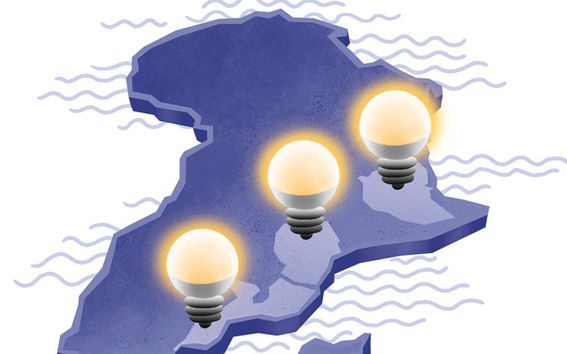Energy-efficient LED light powered by the African sun

Many African homes have no electricity. There’s simply not enough of it to go around, nor does the power grid even extend into remote rural villages. Just one percent of Mozambique’s rural population, for example, has electricity.
Illumination accounts for the majority of electricity consumption in developing countries, and a large share of electrical power is wasted because of inefficient technology and lacking awareness.
“The situation will just get worse if nothing is done. It has been estimated that, by 2030, developing countries will consume 60% of the world’s illumination electricity,” says researcher Pramod Bhusal from the Department of Electrical Engineering and Automation.
The Aalto-coordinated EARLI project develops teaching and research activities associated with energy-efficient lighting and renewable energy in Sub-Saharan Africa. Participants include the University of Dar es Salaam, Tanza¬nia, the Eduardo Mondlane University of Mozambique and the Addis Ababa University from Ethiopia. The project is funded by the Finnish Foreign Ministry through its international university development cooperation programme.
New courses in the pipeline
EARLI was launched in August 2017 at the University of Dar es Salaam. In addition to international university people, the launch event was attended by representatives of Tanzanian industry, energy companies and NGOs.
“We were provided with information from the viewpoint of not only universities, but also society as a whole. Corresponding events took place in Mozambique in September and Ethiopia in October. Lighting technology is not taught at all in Mozambique, while the other two universities have one lecture on this topic as part of an electrical technology course,” Bhusal says.
Now, each university is examining what kind of energy-efficient lighting and renewable energy expertise the nation requires.
“We will convene at Aalto in January to start developing the necessary courses.”
Once the courses and their materials have been finalised, it will be time to train some teachers. The courses will also be tested by implementing intensive trial periods at each university before the final step, when their inclusion in degree programmes will be approved by the participating institutions.
Quality control by laboratories
Improving the energy-efficiency of lighting involves a lot more than just swapping incandescent bulbs for LEDs. It all needs to begin with building design.
“In Africa, we saw how, for example, the dark walls and furniture of office buildings eat up most of the light. Instead of a lighting fixture, a fluorescent lamp with no reflector would be fitted on the ceiling, leading to the loss of a lot of illumination. The windows are small, and little use of daylight is made indoors. Architects and electrical engineers need to be informed about illumination, effective light sources and control systems.”
Tanzania, Ethiopia and Mozambique have no lamp manufacturing of their own. The majority of available technology consists of cheap, crude items, and there is no quality control to speak of.
A lighting laboratory will be established at all three participating African universities as part of the EARLI project, enabling the future testing of all imported lamps and lighting fixtures. The labs will also provide support for teaching and research.
“We are helping the universities procure measuring devices for their laboratories and providing training on how to conduct measurements both on site and here in our own Otaniemi lab.”
Solar panels to shine light on remote villages
In the African countryside, villages are distant from one another and far away from the power grid. Expanding the grid to reach everybody would cost a fortune and take decades. It is much more sensible to generate electricity locally with solar panels, as has increasingly been the tendency in Tanzania in recent years.
“The University of Dar es Salaam provides fine solar energy education, which will be exported to Mozambique and Ethiopia as part of EARLI. For example, we’re organise study projects where energy-efficient lighting is coupled with solar panels.”
It’s possible to achieve a lot when energy-saving lamps are utilised with low-power panels.
“It would be expensive and inefficient to power a 100-watt incandescent bulb with a 100-watt solar panel, when a 10-watt LED lamp can generate the same amount of illumination. LED use makes it possible to illuminate more homes.”
This article is originally published in the Aalto University Magazine issue 21, January 2018. (issuu.com)
- Published:
- Updated:
Read more news

DeployAI Partners Gather for Heart Beat Meeting in Helsinki
The European DeployAI project's partners gathered for the Heart Beat meeting hosted by Aalto University Executive Education in Helsinki.
Get to know us: Associate Professor Maria Sammalkorpi
Sammalkorpi received her doctorate from Helsinki University of Technology 2004. After her defence, she has worked as a researcher at the Universities of Princeton, Yale and Aalto.
A! Walk-Nature connection: Walk, pick, discuss
The afternoon adventure on Lehtisaari offered more than just a walk in the forest; it sparked conversations about renewed appreciation for the simple pleasures of life and the beauty of the Finnish wilderness...